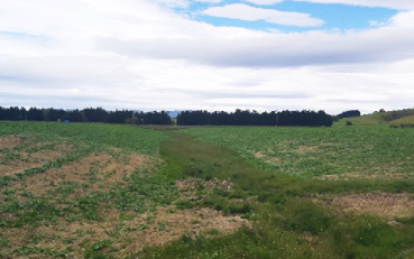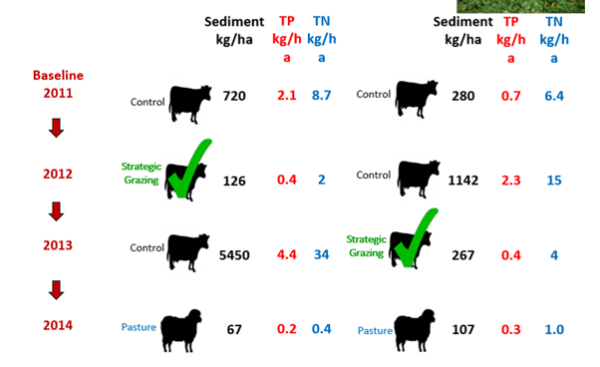Jun 7, 2024
Noticeboard
- Expressions of Interest for the 2024 Next Generation Programme
- Winter grazing
- Native biodiversity on-farm survey
- Jock Allison Obituary
- 2024/25 NZDFA subscriptions Technical Issues - Pls read
- MetService Outlook June 2024
- Joke of the Month
Events
- 2024 Farmers Meet - 17 July - Fairfield House, Nelson
- 2024 Next Generation Programme - 8-9 August, Manawatu
- 2024 National Velvet and Hard Antler Competition, Awards night - 14 December, Invercargill
Expressions of Interest for 2024 Next Generation Programme
We have already received several names of members (new entrants) that wish to attend the Next Generation Programme which will be held in Manawatu over Thursday 8 & Friday 9 August. General registrations will be open by the end June.
Winter Grazing (yeah, sorry we’re still banging on about it)
In the last issue of Stagline we reported on a SCNO workshop on winter grazing, faciliated by Woodbury deer farmer Danette McKeown. Danette and Hamish run a 600 ha mixed drystock system of deer, beef, sheep trading and dairy support. She has a Masters degree in Environmental Science and has been involved in various environmental activities with the deer industry since 2021. Here’s her take on winter grazing and why getting it right is good for your back pocket.
The confrontational wintering regulations are set to be repealed, and while some farmers would prefer any and all external involvement on their farm to cease, the wintering rules seem likely to be incorporated into Freshwater Farm Plans (FW-FP). A lot of the current wintering regulations are based around identifying and protecting Critical Source Areas (CSA’s) with councils continuing to prioritise management of these features during this winter.
Farmers with a bit of topography or some heavy soils will have those areas that are prone to being a bit of shithole (literally and/or figuratively) in winter or when wet. In summer they are often innocuous grassy swales. Perhaps unhelpfully, these areas are often described by regulatory bodies in technical terms, ‘losses to the environment’, ’anywhere on a farm that is at risk of losing contaminants’ and ‘where runoff accumulates in high concentration’. The wintering regulations require CSA’s to be left un-grazed (from 1 May until 30 September), have vegetation as ground cover and not be cultivated into an annual forage crop.


Critical Source Areas left un-grazed (and unplanted). Source: Landcare Trust (top) Otago Regional Council (bottom)
Perhaps CSA management under a FW-FP will recognise change as a progression, be more encouraging and provide long term certainty where farmers can focus on the actual risks to top-soils and nutrients (particularly phosphorus). And while we are aware that there will be times when nature can overcome our efforts (e.g. flooding or prolonged rainfall events), retaining our productive soils would be something that all good farmers would agree on.
The many studies on sediment, nutrient and bacterial runoff (e.g. AgResearch/Telford and DairyNZ) show that up to 90% of soils and/or nutrients can be retained on our paddocks given effective or strategic management. On a gently rolling paddock with unmanaged intensive winter grazing, around 5-6 t/ha of soil and 4-7kg/ha of P is moved through the CSA (see figures). That soil loss equates to only a few mm across the entire surface and may not be very visible when in the paddock, but at a more tangible note, at todays fertiliser prices*, it would be ~$300 of P/ha to replace that lost (and that doesn't allow for the lost soil).

Source Beef&Lamb NZ – summary from AgResearch Trial – Telford
Knowing that daily management of grazed stock can have more impact on soil damage than soil type or winter crop establishment methods is important when looking to improve soil health. The balance between ‘doing the right thing’ and ‘being told’ will be different for every farmer but we are more likely to exclude stock, leave a metre or three as a grass buffer or manage that CSA in any other way that works to retain soil, not because there are rules, but because we understand the benefits to our farms, soils and the environment.

Source DairyNZ
*As at 30 May 2024, $474/t superphosphate
Native Biodiversity on-farm survey
Angela Parkin is a PhD student from Massey University, School of Agriculture. Angela launched a nationwide survey as the first stage of data gathering for her PhD research project investigating collaborations supporting pastoral farmers to integrate indigenous biodiversity management into their farm systems.
If you are a person that farms cattle, sheep, deer or goats in Aotearoa New Zealand you are invited to participate in a short survey.
https://massey.au1.qualtrics.com/jfe/form/SV_diOW0OZFpeIm39s
Research Information Sheet:
Research Project Overview:
https://drive.google.com/file/d/1ZYMU9ZCGVsb-Bn3yqFgBKHnUQqma4aP2/view?usp=sharing
Jock Allison Obituary
Obituary: Dr Jock Allison
Another loss of a pioneering supporter of the industry. This obituary (slightly abridged) is from Dr John McEwan, AgResearch, Invermay.

K Allison
Dr Arthur John (Jock) Allison died peacefully on May 11 aged 80. Jock, to all those who knew him, was a legend in his own lifetime.
His career was closely entwined with Invermay Research Centre over nearly 60 years. He emphasised that the task of agricultural research was not just undertaking rigorous science and its publication, but also ensuring the subsequent adoption in industry of the outcomes.
Jock was passionate about the benefits agricultural research could bring to farming. His early research changed the recommended rates of ram to ewe ratio from 1 to 50 to more than 1 to 100. That simple change has had profound impacts on sheep breeding industry and set the scene for many later developments. His training in reproduction research led him to import Booroola sheep to improve New Zealand sheep reproduction rate. Years later the mapping and identification of the causative mutation was instrumental in creating to what is now the AgResearch Animal Genomics Team. Separately, he was the director of the Invermay campus from 1978-86 and during that time he oversaw the redevelopment of the campus.
He also encouraged the creation of the deer research group during that period.
He was a founding member of what is now Abacusbio an international genetics improvement company based in Dunedin. He was also engaged in a number of governance roles including as a director of AgResearch from 1992 to 1999.
In more recent years Jock is perhaps best known for his successful campaign against consolidating Invermay animal research at Lincoln and Palmerston North. Such a move, he argued, would lessen farmer accessibility to scientists and make their work geographically less relevant.
I now want to emphasise two initiatives that are rarely mentioned about Jock, but which have had a major impact on both AgResearch and New Zealand sheep and cattle industries. In the latter part of Jock’s term as an AgResearch director he was instrumental in convincing the then meat and wool boards in 1997 that what is now Beef and Lamb New Zealand Genetics nProve should be developed using animal model BLUP.
This doubled the rate of genetic change in the sheep industry. He also advocated a central progeny test, but that change resulted from a later separate initiative. Again it had a major impact and increased genetic gain by a further 50%. Using BLNZ figures: lamb production per ewe has increased by 114% since the 1990/91 year. Expressed on a per kg of dry-matter basis it is still a gain in excess of 30%. A major part of that change is genetics.
After he retired as an AgResearch director, his single most impactful action was getting the dairy industry and the meat industry and AgResearch into a single room in Auckland in late 2002 and then obtaining agreement from them to equally contribute for NZ contribution to the sequencing of the cattle genome. That commitment was then in turn matched by Australia, and Canada and along with the major investment by the USA meant the cattle genome was prioritised for sequencing as the first farmed animal species.
Some twenty years later the benefits of that advocacy for New Zealand and the rest of the world are patently obvious to all.
For those wanting some additional background on Jock’s early achievements you can read the Sir Arthur Ward Award 2000 oration and for a more recent summary the article by Neal Wallace from Farmers Weekly.
His passing is a big loss to New Zealand’s agricultural industry, and our thoughts are with Hilary his wife and their daughters Katherine and Amy and families.
Technical Issues - 2024/25 NZDFA subscriptions
We have experienced several technical issues this year when producing and sending out the invoices for the 2024/25 membership renewal.
Please email nzdfa@deernz.org with the invoice number/s and/or details and we will action accordingly if you –
- are a Life Member and should not have received an invoice
- have received an invoice that you were not expecting to receive
- received more than one invoice
- require amendments or need to update details
- have not received an invoice but require one
Please accept our apologies for any confusion this has caused.
Be sure to add nzdfa.accounts@deernz.org in your address book to ensure you receive the invoice.
When making payment via bank transfer please make reference to your invoice number.
BANK DETAILS ARE AS FOLLOWS - 02-0506-0268055-000, please update these to ensure your payment reaches us correctly.
MetService Outlook - June 2024
Issued 04 June 2024
May 2024 - Likely coldest May since 2009, widely dry and mainly fine!
What a difference a year makes? This time last year New Zealand had just come off its warmest May on record, 2C above the long term climate average.
May 2024 has thrown up a drastically different month for NZ. The most noticeable feature has been the cold temperatures experienced right across the country, as forecast in our outlook last month. In a complete reversal from last year, mean temperatures from Northland to Southland have been some 1-2C cooler than average, leading to our coldest May since 2009. Christchurch gave May records a run for their money too; the mercury dropped to -6.3C on Saturday 11th at Christchurch airport, just 0.1C warmer than the lowest May minimum record set in 2015 (with this record extending back to 1954). In Wellington, Kelburn reported its warmest day of the month on the very last day of Autumn (May 31st)!
Frequent southerly winds have been the cause of these cold temperatures, with high pressure systems sat in the Southern Tasman Sea over the first half of the month, often extending a ridge across the whole country. That brought us plenty of crisp, clear and dry weather early on in May, with very little rainfall anywhere across NZ.
From mid-month though, that high cell shifted further NW and has allowed for much more variability on the weather maps, with a couple notable Tasman lows moving onto the country. The second of these features on the 20th/21st brought heavy rain to northern and eastern parts of North Island, and flooding to parts of urban Auckland. Primarily as a result of these couple lows and a day of squally thunderstorms, where close to 1000 lightning strikes and gusts in excess of 120km/h were recorded across the region, Auckland has seen a much wetter than normal month bringing annual rainfall to date near normal after a dry start to the year.
Coastal Gisborne, coastal Wairarapa and much of the Hawkes Bay ended up being the only other wetter than normal regions this month, and this has helped alleviate the risk of drought here, with soil moistures now near normal for the time of year. Southland rainfall tracked along near normal in May, but elsewhere across the country May was notably dry with Dunedin, Westland, Nelson and Buller widely seeing between 10-50% of normal May rainfall. Soils remain drier than average across Canterbury and the upper South Island, with the Kaikoura ranges and foothills extremely dry.
Despite all the cold weather, we only saw a couple notable snow events in May with 30-40cm recorded at Mt Cook Village on May 18/19th, whilst snow settled and stuck around for several days on the Tararua’s earlier in the month (8th), a rare event for May. The ski hills didn’t see any major snow with these wintry outbreaks, especially around Otago, but cold temperatures have enabled snowmakers to get busy and set us up better than recent years heading into the start of the winter snow season.
Climate Drivers – A ‘typical’ winter as ENSO influence wanes
The El Niño Southern Oscillation (ENSO) is now in neutral territory and should remain so throughout winter. Whilst our 23-24 El Niño event has had a definitive say on our weather maps since March, its influence is now expected to wane as short-term variability takes the lead during the winter months.
This, combined with cooler than normal sea surface temperatures around and south of New Zealand (again, very different to last year), is likely to drive a fairly typical winter season as a whole, with lots of variability, plenty of cold snaps and seasonal rainfall and temperature patterns not departing too far from long term climate averages.
This might not seem like a very bold prediction, but following on from four of the five warmest winters NZ has seen since winter 2020, and the wettest winter on record in 2022, just seeing typical winter weather may come as quite a shock to the system! Of course, this doesn’t mean we won’t see departures from normal at a regional level across the country, especially month-to-month, but over the whole season we can expect things to feel different to the winters of recent years which were set against a prolonged La Niña event.
There remains a heightened chance that another phase of La Niña will develop this spring, but its strength and affects on NZ remain far from certain and would likely only become influential over summer.
June 2024 Outlook – Rainfall patterns uncertain as winter volatility kicks in
After a cold Autumn, we start winter on a milder note with the opening half of the month seeing some warmer northwest to northerly airmasses affect the country. At this time of the year these can often be accompanied by broad rain-bearing weather systems moving out of the Tasman Sea, and as we head into the later parts of this week (beginning Mon 3rd) through mid-month a number of these systems could bring bouts of rainfall quite widely, with the heaviest falls favoured around North Island and upper South Island. Portions of the lower South Island, Westland and Fiordland in particular, are expected to see a much drier start to the month than normal, but there is a chance of warm NW rain before mid-month here too.
These weather patterns can also bring very windy spells east of the South Island main divide, and across central NZ. As always as this time of year, watch for when low pressure systems exit eastwards into the Pacific Ocean for any significant snow or cold weather. There remains lots of uncertainty with rainfall and wind details with these systems before mid-month at this stage, and it will pay to keep up to date with your latest forecast at metservice.com.
The second half of the month should see increased potential for multi-day runs of cold, clear and dry weather with higher pressure favoured to become more influential right across NZ. SW winds would be the order of the day, and the North Island should see a drier second half of the month, whilst western areas of South Island see more typical, changeable weather roll through by months end.
So, temperatures should end up near normal, or even slightly cooler than normal, for the month as a whole with colder weather increasingly likely during the second half of the month. Much more uncertainty around rainfall patterns with lots of day-today variability, but a wetter than normal spell before mid-month for North Island, especially the eastern half, drives a wet anomaly here around Bay of Plenty, Gisborne and the Hawkes Bay. Drier than normal conditions are forecast for western South Island, Otago and Southland, but less confidence in this aspect of the forecast where much could depend on just one heavy rain event before mid-month. The rest of the country should see near-normal rainfall this June.
|
Bottom Line A mild start to the month, with a few rain bearing northerly systems set to bring a rather unsettled week two for the North Island. The second half of the month looks cooler, drier and more settled overall bringing temperature anomalies closer to normal, but most likely resulting in some rainfall deficits for western and southern South Island by the end of the month. |
You can sign up for the MetService's Monthly Outlook right to your inbox - click here to subscribe.
Source: https://www.metservice.com/rural#monthly-outlook
Events
If you have an event that would be of interest to the deer farming industry, please email info@deernz.org with details.
2024 Farmers Meet
Fairfield House is the venue to be at for an evening of networking and socialising. This will be an opportunity to meet with DINZ representatives and local farmers.
For further information please click here DINZ Farmers Meet
2024 Next Generation Programme
The 2024 programme comes to Manawatu over Thursday 8 and Friday 9 August. Further details to be provided.
2024 National Velvet & Trophy Competition
The 2024 Awards Night has been confirmed for Saturday 14th of December. Contact southlanddeerbranch@gmail.com for any enquiries. Details will be updated here when available >>

